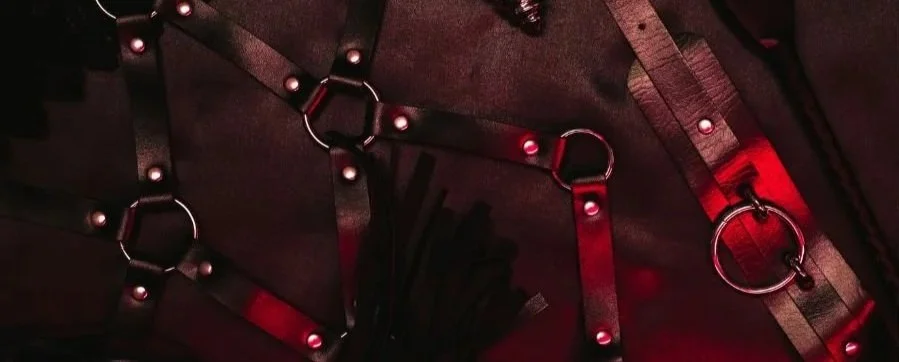Unseen Service: Invisible Labor is D/s Dynamics
When we talk about D/s, the flashier tidbits tend to steal the spotlight: the power dynamics, the rituals, those wonderful toys. We love a good protocol and a well placed boot. But what really makes it work? The silent labor, the unnoticed effort that keeps it all from crumbling.
Invisible labor is the work that doesn’t always look like work. It’s the emotional monitoring, the remembering of rituals and rules, the prep that goes into scenes, the energy spent holding space, adjusting tone, or navigating drop. It’s setting the mood, tracking triggers, buying the aftercare snacks, and texting reminders about posture checks. It’s not always hot. It’s often unrecognized. But it is absolutely real.
Think of someone in a 24/7 dynamic who keeps their partner’s needs in mind, ensuring that the interactions, energy, and flow of the relationship align with the dynamic they've both set out to build. It’s not glamorous, but it holds more weight than it gets credit for.
Want to be a better partner? Ask: “What’s something you do for me that I might not even notice?” Then shut up and listen. No fixing. Just witnessing.
Who’s Doing the Work? (And Why It’s Often Lopsided)
Let’s be real, just because someone’s holding the leash doesn’t mean they’re carrying the load. Invisible labor has no respect for traditional power dynamics. Like in the case of a Dom keeping the emotional atmosphere steady while their sub is quietly orchestrating every detail of planning, organizing, and tracking what’s needed for a scene. The work isn’t always where you think it is.
In many dynamics, the weight tends to fall on those who are more service-oriented, emotionally attuned, or simply more experienced in the mechanics of relational upkeep. For example, submissives may take on extra tasks to prove their devotion or avoid disappointing their Dominants. D-types, especially those with a nurturing style, might silently absorb emotional stress so the scene partner can fully surrender.
The division isn’t always intentional. Sometimes it’s inherited from gender norms, past dynamics, or assumptions about who’s “supposed” to do what. And often, the person doing the work doesn’t even know how much they’re carrying, until they burnout.
Imagine a submissive who maintains a list of their Dom’s daily preferences, checks in about future scene details and desires, and keeps track of protocol tweaks over time. Their Dom may assume everything is running smoothly, not realizing that smoothness is the result of ongoing behind-the-scenes effort.
Now flip it. Imagine a Dominant who manages multiple play partners across different time zones. They coordinate scene calendars, follow up post-play, remember everyone’s emotional triggers, and write detailed notes about evolving dynamics. To a casual observer, it looks like they’re effortlessly in control. In reality, they’re juggling a high-level emotional spreadsheet in their brain.
This work matters. But when no one talks about it, it becomes expected rather than appreciated.
Want to be a better partner? Instead of assuming, ask. “What feels like work for you in our dynamic?” Then ask again in three months. Because dynamics evolve, and so does the labor.
What Counts as Labor?
Let’s break it down. Invisible labor can look like a lot of different things in a given relationship, but here are a few you may recognize:
1. Emotional Self-Regulation
Emotional self-regulation isn’t just about staying calm, it’s about keeping it together when your partner pushes all the right buttons...and a few wrong ones. It’s the art of managing your internal weather system while staying present in your role. Whether you’re a Dominant pausing to adjust your tone when your partner missteps during a protocol, or a submissive choosing to take a deep breath when you're corrected mid-ritual, this kind of emotional pause is labor. You’re analyzing triggers, regulating responses, and holding your feelings without necessarily offloading them in the moment, all while maintaining the structure of the scene or the dynamic.
It doesn’t always get noticed. In fact, it’s often designed not to be noticed. But keeping your cool in a moment of tension can shift an entire scene from derailing into deepening.
Imagine a scene where the power dynamics are in full play, but the Dominant suddenly feels a shift in their partner’s energy. Perhaps they’ve dropped into subspace more quickly than usual, or due to family or work pressures, they’re not as present as the Dominant anticipated. Rather than forcing them back into the moment, the Dominant decides to adjust. Understanding that every scene has its rhythm, and sometimes the power lies in knowing when to pull back.
That inner work, quiet, invisible, but effortful, is what keeps the dynamic safe and steady.
Appreciation Practice: Consider building a quiet ritual where your partner plays a specific song, lights a candle, or makes a comforting drink for you at the end of a high-emotion day, just to say, “I see you holding steady. I know that took something.”
2. Tracking Protocols
Remembering to greet a Dominant a certain way, tracking grooming standards, logging rituals, and not needing reminders? That’s a mental load. You’re holding a playbook in your head 24/7. And unlike a vanilla job, there’s no built-in performance review, no quarterly bonus, no HR department drafting a shiny gold star report. The reward is often just the satisfaction of doing it right—or the crushing silence when it goes unnoticed. That kind of unacknowledged consistency takes mental stamina, especially when expectations are high but affirmation is low. Tracking protocols isn’t just about remembering, it’s about precision, timing, and internalized standards that rarely come with applause.
Imagine a submissive who has ritualized days. These co-created rituals include greeting their Dominant a specific way, preparing meals, setting out toys for play, tracking meds and water intake, and ensuring their posture is on point throughout the day, just to name a few. Not all of them are tracked on paper, but each one takes focus and energy, a quiet, ongoing commitment. Mental and physical tracking of multiple rituals and expectations requires consistency, concentration, and emotional bandwidth, supporting the dynamic without fanfare.
Appreciation Practice: Build in the fanfare! Design a weekly praise list. Every Sunday, each partner names three silent efforts they noticed and valued that week. Bonus points if stickers and glitter are involved.
3. Scene Planning
You know that jaw dropping, breath stealing, ho-lee-fuq scene that looks like it was conjured out of thin air? Surprise! It wasn’t. Scene planning is the full backstage production that makes the magic happen. Think prop master, stage manager, lighting tech, intimacy coordinator, and emotional director, all rolled into one latex-clad powerhouse.
Whether it’s a spankee setting the scene to music (with a beat to beat to), adding essential oils to please the senses, having aloe vera at the ready, and acceptable thwaking toys within easy reach, or a Dom designing a high stakes CNC scene complete with playlists, costume changes, bondage gear, and negotiated checkpoints. This is labor. Physical, emotional, and mental.
It includes cleaning and prepping gear, selecting the right toys for the scene’s arc, staging the environment for safety, timing breaks, setting the vibe, and (let’s be honest) possibly Googling “how many candles is too many before it becomes a fire hazard.” This isn’t just foreplay, it’s project management kinkified. The kind of prep that looks invisible if it’s done well, but makes all the difference when it’s not.
And all of this happens before anyone even picks up a flogger.
Appreciation Practice: After a scene, take 5–10 minutes to debrief. Not just about what felt hot, but what took effort and prep. Ask: “What went into this that I didn’t see?” Then hype them like they just won a Tony Award for “Best Kink Scene Direction.”
4. Emotional Caregiving
Emotional caregiving is the glue that holds a dynamic together during its most tender, and most volatile, moments. It’s not just being there, it’s how you’re there. It means noticing the shift in your partner’s breathing, tracking their emotional responses throughout a scene, and adjusting your energy without needing to make it about you. It’s empathy in motion, without applause or a spotlight.
Sometimes it means sitting silently in presence while someone processes shame, grief, or joy. Other times, it’s offering a grounding touch, validating their experience, or simply staying present so your partner knows they’re not alone. Even after something intense has cracked them wide open.
It also shows up outside of scenes. Emotional caregiving might look like texting a check-in when you know someone has a hard day ahead, remembering the anniversary of a difficult event, or asking deeper questions than “how are you?” and actually being ready for the answer.
Whether it’s supporting your partner through grief, navigating drop, or holding them while they process a hard truth mid-scene, this work is invisible, draining, and deeply sacred.
And holding space without needing to fix? That’s a next-level skill.
Imagine a partner who sits beside their scene partner after a cathartic release, offering a blanket, gentle touch, and total presence. They don’t analyze the moment or redirect it. They just witness. That witnessing can be more healing than anything scripted. And it requires energy, attunement, and patience, not just proximity.
Appreciation Practice: Give a reflection of what your partner gave emotionally. “When you held space for me like that, I felt safe in a way I didn’t even know I needed.” Honest, specific feedback makes invisible work visible.
5. Logistical Support
You know those magical scenes that happen exactly when and where they’re supposed to, with all the right gear, Hitachi fully charged, a stocked aftercare bag, and everyone showing up on time with the right headspace? That doesn’t happen by accident. That’s logistical labor, baby!
Whether it’s a one-on-one dynamic or a polycule wrangling multiple scenes across multiple cities, logistical support is the invisible infrastructure that makes the visible kink possible. It’s the planning, scheduling, checking, tracking, packing, and confirming. And while it doesn’t look sexy on the surface, it’s foundational. You can't have kink chaos if no one booked the Airbnb.
This work often falls to the partner who’s more organized, more available, or more invested in keeping things smooth. But even when it’s chosen willingly, that doesn’t make it effortless.
Imagine someone planning a multi-day event where two partners are flying in for a weekend of play. They coordinate arrivals, book accommodations, communicate preferences, confirm what gear and furniture is available, and pack everyone's favorite snacks. They also keep track of limits, drop histories, and emotional triggers, all while making sure the dog gets walked and the wine gets chilled. That’s not “being helpful.” That’s orchestration in a leather harness.
Appreciation Practice: Start a monthly ‘Logistics Toast’ to give credit where it’s due. Whether it’s getting the schedule sorted, organizing the gear and remembering to bring extra lube, or prepping the aftercare blankets ahead of time. If it helped make the magic happen, it counts.
6. Post-Scene Care
The scene might end when the flogger hits the toy bag but your nervous system didn’t get the memo. Post-scene support is one of the most quietly crucial forms of invisible labor in kink. It’s about tending to the body, yes, but also tending to the mind, the nervous system, the heart, and sometimes the emotional landmines that got kicked up mid-play.
This care starts the moment a scene ends. It can include wrapping your partner in a blanket, bringing them water, applying aloe to sore skin, or just sitting in stillness while they come back to baseline. But it doesn’t stop there. True post-scene care extends into the hours, the days, sometimes even weeks after: checking in via text, validating emotional responses, reminding your partner they are safe, seen, valued, and not villified. Especially if the scene was edgy, emotional, or left them raw.
This care often goes unnoticed unless it’s missing. But for many, it’s the part that makes intense play sustainable.
Imagine someone who, after a powerful scene, has an aftercare playlist ready, preps a comforting drink, tucks their partner into bed with a gentle affirmations, and snuggles them to sleep. They follow up the next day with a grounding text, offer space to talk, and suggest a shared cozy activity. These aren’t grand gestures, they’re anchoring ones. They say, “You weren’t just a body I played with. You’re a person I care for.”
Appreciation Practice: Create a post-aftercare ritual where partners share what made them feel held, seen, and cherished. Make it sacred. Bonus points if you bring snacks as delectable as your connection.
Want to be a better partner? Pick one of these practices and try it this week. Not to perform. Just to appreciate. Because the more we name the invisible, the more we make it matter.
Making the Invisible Visible: Negotiation & Acknowledgment
Invisible labor stays invisible until someone points a spotlight at it, and not the sexy interrogation-scene kind. We’re talking about shining a warm, steady light on the work that keeps your dynamic running smoothly, even when nobody’s moaning about it.
You don’t need to put a dollar value on every emotional check-in or waxed paddle. But you do need to talk about who’s doing what, and whether the weight is shared, acknowledged, or just silently expected. Because if it’s not seen, it often becomes assumed. And assumptions left unspoken tend to become expectations without consent or conversation.
This isn’t about blaming or shaming. It’s about clarity, sustainability, and connection.
Try asking each other:
What kinds of behind-the-scenes work do I do for you?
What do you wish I noticed more?
What feels like “just part of the job” but still takes energy?
What do you do that you worry I take for granted?
These questions are especially helpful during renegotiation windows, but honestly? You don’t have to wait for a contract update to have this conversation. Try having a quick labor check-in once a month (ideally with snacks) and zero defensiveness.
Imagine a mid-month check-in, where the partners realized the Dom was doing most of the emotional holding, coordinating, and directing scenes, while the sub was keeping the house clean and doing 100% of the post-scene gear cleaning. They weren’t mad about it. They just hadn’t named it. Once they did, they were able to show appreciation for the work each of them did to make things run smoothly.
Want to be a better partner? Normalize mid-cycle check-ins. Not just Is the heat still there?”but Are we still holding the weight fairly? Are we both feeling seen and supported? Bring some honesty, curiosity, and a mountain of recognition to the table. The more visible the labor, the less likely it is to turn into resentment and bitterness.
Making It Sexy (or at Least Sacred)
Invisible labor isn’t inherently erotic. But you can ritualize it. You can celebrate it.
When we take the time to honor the work that holds our dynamics together, we transform it from a silent expectation into an intentional act of devotion. And no, that doesn’t mean you need to break out the confetti and throw a parade every time your partner organizes the toy bag (but if it makes you both smile, go for it!) It just means making space to say, “I see that. I value that. Let’s mark it.”
This is where ritual comes in. Not the high-protocol kind (unless that’s your thing), but small, accessible, repeatable practices that make invisible work feel visible, valued, and maybe even a little bit hot.
Ideas to spark your ritual imagination:
Silent Gratitude Signal: Consider developing a shared gesture like a hand on the chest, a whispered word, or a simple wink that silently says “I saw that invisible thing you did and I appreciate you.” Use it in scenes, rituals, or daily life. Quiet, mutual, powerful.
Affirmation Rituals: Add a service-focused ritual that affirms rather than evaluates. A sub might kneel not for inspection, but to receive acknowledgment. A Dom might receive a written thank you, naming the subtle ways they anchored the dynamic by holding emotional space, setting the tone, and protecting energy like it was part of the protocol.
Holding Ritual: Borrow from aftercare and create a recurring moment for emotional check-ins. Light a candle, put on (or take off!) cozy clothes, and share the invisible labor you’ve each been holding that month. Trade appreciation. Maybe cry. Maybe laugh. Maybe spoon until a limb falls asleep. Let it be whatever you need.
Invisible Labor BINGO: Yes, BINGO. Make custom cards with your common behind-the-scenes tasks (e.g., “Prepped aftercare kit,” “Managed emotional tone,” “Handled logistics for playdate”). When someone hits BINGO, they get a reward, be it a massage, control of the next playlist, or their favorite home-cooked meal. Frame the winning BINGO card if you're dramatic (and you are).
Host a Love-in: Invite folks in your inner circle or polycule to an Invisible Labor Love-in. It’s part ritual, part roast, part cuddle puddle. Each person shares one form of invisible labor they noticed someone else doing. Then they hype them up like they just finished a triathlon in ballet boots. Laughter, tears, blanket forts, the works.
Want to be a better partner? Make recognition and appreciation a frequent, regular part of your dynamic. Don’t wait until your person is falling apart to tell them they matter. Don’t let “thank you” be something that only happens when things are unraveling. Weave celebration into your reg ular rhythm, so appreciation becomes as natural as breath, flowing freely and often.
Do Your Own Audit: Who’s Doing What?
Let’s be honest, even the most well-meaning dynamics can slip into autopilot. Tasks get divvied up without discussion. Emotional labor becomes assumed. And suddenly someone’s running a full-time kink concierge service with zero recognition. That’s where the Invisible Labor Audit comes in.
This isn’t about blame. It’s about clarity. It’s about surfacing the hidden work, naming it, and asking: Is this sustainable? Is this fair? Does this feel good?
How to do an Invisible Labor Audit:
Step 1: Name It All
Individually (and without censoring yourself), write down all the ways you contribute to your dynamic. Include:
Emotional support (aftercare check-ins, pre-scene encouragement)
Logistical efforts (booking spaces, organizing toys)
Protocol tracking (rituals, greeting rules)
Scene planning or coordination
Household support (if you live together)
Social or polycule management
Anything else you do to maintain the vibe
Don’t minimize it just because it feels “small.” If it takes effort, attention, or care it counts.
Step 2: Reflect on Visibility
Next to each item, mark:
Is this noticed or acknowledged regularly?
Is this valued, appreciated, or reciprocated?
Is it expected without discussion?
Does it feel like a choice or an obligation?
This is where invisible becomes visible. Be honest. Be curious, not judgy.
Step 3: Swap and Read
Trade papers or screenshots. Take a breath. Sit in silence for a few minutes while you read. Notice what you didn’t know your partner was doing.
No reacting, just absorbing. Resist the urge to explain or defend. Just take it in.
Step 4: Discuss with Curiosity, Not Judgment
Now that the labor has been named and exchanged, it’s time to talk about it like grown, emotionally intelligent kinksters. This isn’t a fight. It’s a moment to be seen and to see each other more clearly.
Start with empathy. Remember, both of you probably did more than the other realized. It’s not a competition, it’s a mirror.
What surprised you? What stung a little?
Was there anything that made you feel especially seen or unseen?
What do you want to appreciate more actively?
Are there things you’ve taken on that now feel more like obligation than choice?
Where do you feel stretched too thin? Where are you nailing it?
What would it look like to make this more balanced, without anyone feeling like they’re being graded?
Create space for real talk, not reactive talk. If emotions rise, take a pause. This part is sacred because it’s the moment invisible labor starts becoming conscious co-creation.
Step 5: Rebalance the Dynamic
Now take everything you’ve surfaced and actually do something with it. Rebalancing doesn’t mean aiming for perfect 50/50 symmetry. It means finding a rhythm that works for both of you and feels good in your bodies, minds, and dynamic.
Start with what’s working. Name it. Celebrate it. Affirm what feels aligned. Get clear on what is a gift and what is a responsibility.
Then look at what feels heavy, overlooked, or misaligned. Redistribute labor in a way that honors capacity, not just desire. If someone’s naturally great at logistics but they’re burned out, maybe it’s time to rotate roles or delegate more. If a task feels like service to one partner and invisible obligation to the other, that’s a cue for renegotiation.
Ask yourselves:
What do we want to keep exactly as it is?
What’s feeling lopsided, and how can we rebalance it?
Are there things you’re willing to shift, share, or release?
What kind of invisible labor feels good to give, and why?
What responsibilities are truly consensual? And which ones just kinda happened without you noticing?
Where can we build in more visibility and appreciation?
Set a follow up check in a month or two down the line. Don’t treat this like a one time reset. Treat it like a tune up, a refinement. Because labor (like kink) is never truly static. Rebalancing isn’t a failure. It’s maintenance. And the best dynamics get better with practice, feedback, and care.
Imagine a D/s couple who realize during their audit that while the Dom had taken on most of the protocol tracking and emotional caretaking, the sub had quietly become the default coordinator for their polycule's events, travel plans, and gift-giving rituals. Neither had fully clocked how much mental energy it took. Now, they have a shared calendar, co-plan events, and alternate who handles upcoming holidays and anniversaries so no one’s stuck being the social secretary forever.
Want to be a better partner? Don’t just do the audit, act on it. Adjust your expectations. Redistribute tasks. Celebrate what’s working. Grieve what didn’t. Then co-create something better. Make invisible labor part of your ongoing negotiations, not just your emergencies.
Make It Seen, Make It Sacred, Make It Sustainable
Invisible labor isn’t just some vanilla buzzword. It’s alive and well in our kink worlds, our rituals, our homes, and our hearts. It’s the quiet current that keeps the power flowing between partners, whether you’re planning a full-on formal collaring ceremony or just figuring out who’s packing the aftercare snacks.
When we name the work, we honor it. When we share the load, we grow trust. And when we turn the invisible into something intentional (whether through ritual, a spreadsheet, or a cheeky BINGO card) we create dynamics that are not just hot, but also humane.
Power exchange doesn’t need to be flawless, it needs to be intentional. When we notice the invisible, appreciate the effort, and respond with care? That’s where resilience and connection are built.
So go forth. Notice the unnoticed. Celebrate those sexy spreadsheets. And if no one’s told you lately, all that quiet effort you’ve been putting in? It matters. You matter. And you deserve to be seen.














